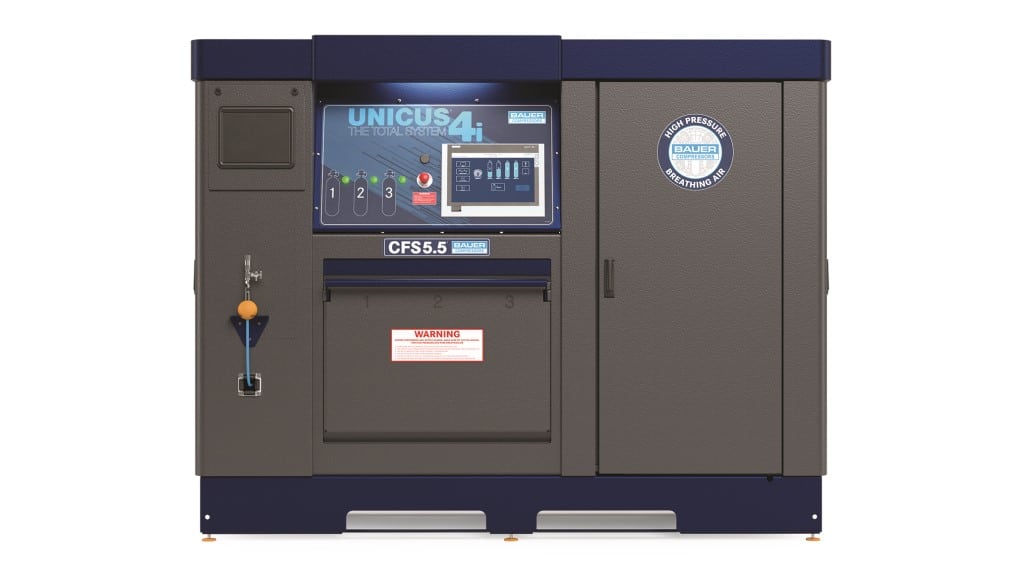Breathing life into the fire industry with BAUER
- October 18, 2023
- 8:24 am


Iain Hoey
Share this content
Bill Dickson, Sales Manager at BAUER, sheds light on how tradition meets innovation in the rapidly evolving breathing apparatus industry
With a professional career spanning nearly 40 years, Bill Dickson, Sales Manager at BAUER, has witnessed, and been a part of, the evolving complexities of high-pressure breathing air in the fire industry.
He takes us through his journey at BAUER, a company that is as much about tradition as it is about technological advancement.
What are the primary factors driving the need to advance breathing apparatus technology?
Over the years, Self-Contained Breathing Apparatuses (SCBAs) have undergone significant technological advancements.
In the past, SCBAs were equipped with aluminium cylinders that were bulky, heavy, and cumbersome.
These earlier models operated at lower pressures, around 2216 or 2200-bar.
Fast forward to today, and we have SCBA cylinders constructed from carbon fibre composites.
This evolution has led to a much lighter and compact design, while simultaneously increasing the air capacity.
Such advancements ensure firefighters can execute their responsibilities with less concern about depleting their air supply.
Modern SCBA cylinders can now provide over an hour’s worth of breathing air at 5500 psi — a milestone that was unimaginable just two decades ago.
Can you explain the features and differences between the Unicus 4 and 4i?
The Unicus line consists of two primary models – the Unicus 4S is the analogue version, while the Unicus 4i is its electronic counterpart. The ‘I’ in 4i stands for intelligence.
Traditionally, fire departments had a three-part system: a compressor, an air storage system for processed breathing air, and a filling ramp fixed to the wall for transferring the stored air into the SCBA.
This older method was neither user-friendly nor particularly safe.
The Unicus system revolutionises this by consolidating these three components into a single cabinet.
The chief advantage is the ease of installation – you only need to provide an electrical connection.
There’s no hassle with interconnecting wires or tubes between separate components.
For safety, when filling an SCBA, we use what’s known as a containment fill station.
This station is specifically designed and third-party tested to capture fragments in the unlikely event of an SCBA rupture.
In contrast to traditional methods where the SCBA is exposed, our system contains it in a secure box, ensuring operator safety.
This containment meets the standards set by NFPA 1901.
Distinguishing the 4s from the 4i: the 4s, designed with my generation in mind, uses pressure gauges, valves, and has a tactile interface with numerous knobs and buttons.
On the other hand, the 4i is more technologically advanced. It uses a touchpad and a 15-inch screen affixed directly to the Unicus unit.
From this interface, one can control various features like fill pressure, fill rate, monitor air quality, and even oversee the system remotely.
Imagine being a fire chief wanting to check on the compressor from a different location; with the 4i, it’s entirely possible. BAUER is pioneering these technologies, setting us apart in the industry.
Can you shed light on BAUER Connect?
BAUER Connect is an innovative feature integrated into the control system of the 4i. It links everything to the cloud.
For instance, while filling an SCBA, a fire chief can access their BAUER Connect Cloud account and monitor real-time compressor parameters – from pressures to air storage and even operator details.
The system also enables firefighters to log fill events digitally.
This data, stored securely in the cloud, replaces the traditional method of recording with pen and paper, which often goes neglected.
How is this data utilised?
The data serves multiple purposes.
It helps in scheduling services, air tests, and monitoring the SCBA inventory, which is a valuable asset.
It informs users when an SCBA needs hydro testing or when its lifespan concludes.
Essentially, the system tracks about five crucial parameters just for an SCBA fill event.
If you’re interested, I can provide a copy of the NFPA standard, detailing the comprehensive data points it manages.
The essence is that we’re shifting knowledge from one’s memory to a cloud-based system.
How receptive is the industry to such advancements?
The industry is embracing this technology. As the older generation retires, the incoming generation is stepping into pivotal roles within fire departments.
They are keen on leveraging technology, driving this shift.
Can you tell us about the RFID Pro?
The NFPA Standard 1989 requires fire departments to manually document each SCBA fill event.
This often proves to be cumbersome, and many departments skip it. RFID Pro aims to streamline this process.
RFID Pro is a handheld device compatible with any compressor and SCBA manufacturer.
It allows operators to digitally record SCBA fill events effortlessly.
The device can read either the barcode or an RFID chip embedded in the SCBA.
To record a fill event, you simply scan it using the RFID reader.
This information is then uploaded to a unique BAUER Cloud account.
Do you have any additional insights on breathing apparatus?
It’s less about the apparatus and more about understanding the importance of breathing air.
Many assume it’s simple and safe, but that’s not always the case.
Recognising and adhering to NFPA standards is crucial for the safety of firefighters.
When these guidelines aren’t followed, dangers can arise.
Simple practices, like using a wall-bolted fill panel or filling an SCBA without proper precautions, can lead to serious injuries or even fatalities.
At BAUER, we view this as risk management.
Our aim is to equip frontline responders with the right tools to ensure their safety, so they return home to their families after duty. Unfortunately, many overlook these essential standards.

